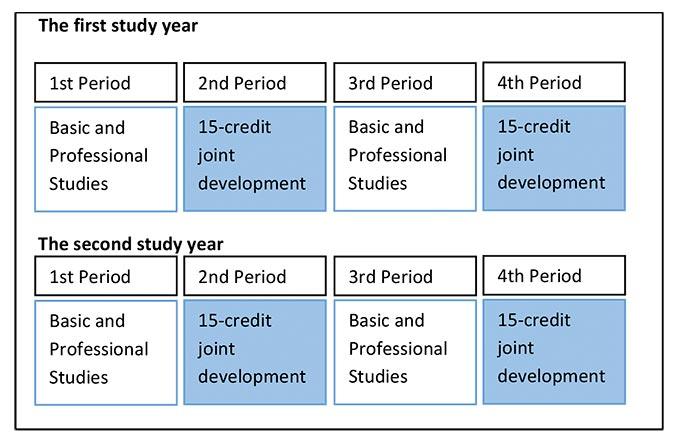
Author: Eero Nousiainen.
Introduction
The amount of completed degrees can be considered as one of the key criteria for assessing how universities of applied sciences (UAS) have succeeded in achieving their goals and how necessary and viable the new qualifications that have taken place in the workplace are. Also, one of the key objectives of UASes is their local impact. The task of UAS is to strengthen regional development and to respond to the needs of regional higher education.
Understanding and using open innovation enable the university to remain competitive and to respond rapidly and flexibly to changes in the environment, despite the development time and life cycle of products and technologies. By developing education continuously and by being in close cooperation with companies, the university has a better chance of achieving its goals.
Open Innovation Inside the Curriculum
One of the special features of UAS is a strong link with the needs of working life. Curricula and qualifications are designed to serve professional expert tasks. There is a clear need in the Finnish higher education field for work-oriented higher education degrees, where the curricula is based on a vision of the needs of business life. Since higher education is largely financed by public funding and its state funding is unlikely to increase significantly in the next few years, resources must be used to the fullest.
According to the principles of open innovation, all the top specialists in the education field are not working at our university but also in companies that we are dealing with. We must work with competent people both inside and outside the university. If we create the best possible combination of internal and external ideas, we have the opportunity to achieve even better results in the meaningfulness and motivation of the studies, which has a positive impact on the progress of the studies and graduation within the normative time.
Structure of the Curriculum
The structure and contents of the Degree Programme in ICT of Oulu University of Applied Sciences (OUAS) are designed to meet the needs of working life. In this model, students study basic and professional studies at OUAS for 2.5 years. After that, they have the opportunity to study for 1.5 years in different companies. In these companies, they do different development tasks in cross-sectoral and multicultural teams.
The first and second study year
During the first and second year of studies, students study 120 ECTS credits of basic and professional studies in each Option of ICT curriculum. The structure of the studies is shown in Figure 1, where each period of the academic year is compiled into one joint development project of 15-credit.

Each joint implementation has its own theme, and in addition, these collaborative implementations include basic and professional studies combined into one entity. During the first two years, there are four joint implementations. Each joint implementation takes one period and each joint implementation is preceded by basic and professional studies. The common teaching method is based on problem-based community learning and project-based teaching methodology. Basic and professional studies provide for the necessary basic information for future joint implementation and provide a basis for project execution. In lectures, there can be people from industry telling from their point of view issues related to the theme of the implementation and thus motivating the students in their studies.
The third and fourth study year
The third and fourth year studies comprise the study path shown in Figure 2.
Company-Oriented Product Development Projects I-III are studies of Information and Communications Technology at Oulu University of Applied Sciences. The total number of studies is 30 ECTS credits consisting of three parts of 10 ECTS credits. R & D projects are generally carried out starting from the third year. At best, different product development projects will lead the students to a flexible start of the bachelor’s thesis, graduating within the normative time and even finding their first job.
In the development project work, the student becomes acquainted with the tasks related to the requirement analysis, as well as design and implementation of the project. The aim is to deepen the work skills required in IT projects while at the same time to acquire practical technical expertise in the target system. The tasks are defined more accurately by projects. Projects can be individual development tasks, but they can also be targeted at one and the same development task or target system.
After completing the first company-oriented project, the student will start working as a summer trainee for the company where they have made the project. After the summer work has finished, the student can continue in the company and start their second company-oriented development project. The bachelor’s thesis is the last work to be done in this study path. Both companies and students have found this continuum meaningful.
In addition, the projects prior to the free-choice study package of 15 ECTS can be directed to support the product development projects. The student can allocate 90 credits to these work-life based studies.

Projects will be launched in both autumn and spring semesters. The course aims to be implemented in as realistic conditions as possible, under the guidance of IT teachers and people working in the company. Project penetration always follows a certain process whose starting points and the desired result are clearly defined. The good design of the project creates the conditions for the success of the project. In this case, timetables are defined, resources are allocated and the working methods used in the project agreed on.
The educational objectives of the third and fourth year studies
After completing third and fourth year studies, the student gets an idea of how the company works and experiences practical teamwork. The student is able to apply the previously taught theory in different courses. The student also understands the significance of project work as the work proceeds and knows how to act as a member of a project team. In addition, one of the teaching objectives is that the student masters the use of the methods and techniques used in the project.
The product development project, designed and implemented with good objectives and resources, provides a variety of positive developments. It always increases the customer’s knowledge of the project area. It increases the student’s expertise and provides a good experience for future project work and career development. A good project is valuable to all those involved in it. At its best, open innovation based co-operation between the university and companies will
– develop the company’s operations and processes
– provide more functionality to the company’s product
– create traineeships and permanent jobs
– promote the introduction of different technologies
– increase co-operation between different organizations
– be disseminated and widely exploitable
– have a positive impact on the environment
– promote the university way to co-operate with companies
– work as a new constructor of the teaching profile
The successful completion of the project naturally requires that the company has a real problem to be solved. Students’ know-how (i.e. completed studies, competence and practical experience) should always be taken into account when defining the problem.
To accomplish this task, the project team needs adequate resources and support throughout the project. The company’s genuine, continuous interest in the project work and its outcomes directly affects the project team’s motivation, work and project results.
Summary
The feedback – on the ICT curriculum of OUAS – from companies, students and teachers is generally positive. The curriculum is contributing to the renewal of teaching technology and to the growth of a new kind of education culture. In this culture, teachers are no longer just the puppeteers in the classroom, but they are working together with colleagues and people in companies in multicultural teams.
In this competitive world, if universities want to ensure a good economic performance, they have to produce innovative study possibilities, meet their customers’ (i.e. students and companies) needs, and respond quickly to market demands. Because of that, universities must understand that they do not necessarily have all the competencies to perform every operation themselves.
Author
Eero Nousiainen, M.A., Team Manager, Oulu University of Applied Sciences, eero.nousiainen(at)oamk.fi



